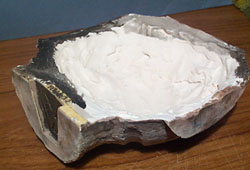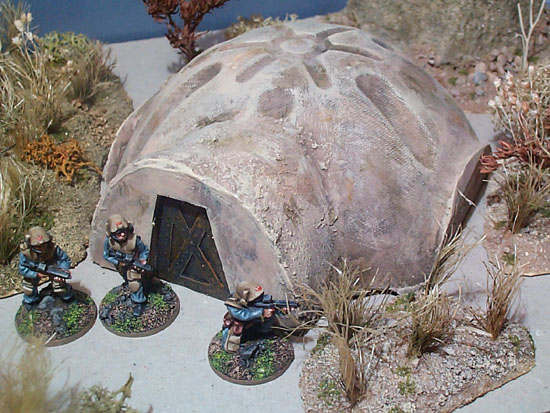|
Making the mould/formwork
Cut off one compartment of the melon tray. There will be gaps at
the sides where it joins to the neighbouring compartments. The pleasing
grooves on the building are formed into the bottom of the tray that
I had. Roughly cut pieces of card and tape them on to plug these gaps
up.
Casting the building
Mix up some plaster with not too much water so it fairly thick, which
it will stop it oozing too much out of cracks in your makeshift mould.
Spread a half inch thick layer over the inside of your mould. Next put
in some reinforcement. Net curtain material is very good, but you could
just toss in lots of bits of string (the rougher and looser weave the
better). This will strengthen the plaster against cracking. Now add
another layer of plaster so you have a 1 to 1½ inch layer over the entire
inner surface of the mould. Leave it to set for at least an hour. The
plaster will be fairly hard in a few minutes, but you should leave it
for a good long time to harden to avoid it being damaged when you remove
the mould. Now peel the cardboard off the outside of the buiding. It
will probably come off in small bits, so it is a one-use mould only.
Making the entrance
This is a tricky one. I cut a façade of foamcard, with a rough arc
of card behind it to fill the gap to the main dome. This was then built
up with thickly mixed plaster and finally filed off. All in all this
wasn't very successful. It was laborious, not really neat enough and
the texture didn't match.
What I probably should have done
With hindsight I would have built the entrance into the mould from
a piece of card bent into a curve and then glued to a flat piece with
a curve cut into it to form the shape. Then I would have glued on the
foamcard façade at the end to give a nice flat front and recessed doorway.
Finally I would have filled any gap between the foamcard and the main
building with plaster.
Making the door
Cut the doorway from the foam card and then glue the same piece
back in but set back by about half the width of the foamcard. To
add some detail cut a piece of thin card to the same size and then
remove four triangles from it to give the impression of reinforcement
bars. You will need to draw these on with a pencil to get the triangles
in the right place. |
 |
Adding recessed detailing
Take a scalpel, large needle or any other pointy bit of metal and
scrape in some grooves. A circle template (as used for technical drawing
work) can be used for circular grooves to represent hatches or access
panels. If you are using a scalpel then be careful not to ruin your
template by cutting bits out of it. You can also make straight grooves
using some kind of flexible straight edge such as the edge of a piece
of plastic packaging.
Adding raised detailing
Stick on some little rectangles of card. A thin card should be used
so that it can be bent to the curved surface of the plaster. You could
also add assorted bits box items such as bits of pens and plastic toys
to resemble vents etc. Absorbent material such as card should be stuck
with PVA, metal and plastic with epoxy resin. Super glue is not very
good because the plaster is so absorbent.
Painting the dome
- The dome was given a coat of masonry paint to seal the porous surface
of the plaster.
- This was followed by a coat of brown emulsion
 . .
- Next a dark brown wash was applied
 . .
- A fairly wet drybrush with the original colour
 . .
- A dryer drybrush with the original colour mixed with a pale cream.
- A very dry drybrush of the cream colour
 . .
- Finally the dome was stained with patchy washes of differene browns
and dark greenish browns. In some case these were smeared (using a
finger) and in some areas a light drybrush of cream was applied over
the top.
Painting the door
- Black basecoat
 . .
- Drybrush with dark silver/gunmetal.
- Patchy drybrush of chestnut brown to simulate rust
 . .
- Light wash of dark brown
 . .
|
![]()

![]()
![]()

